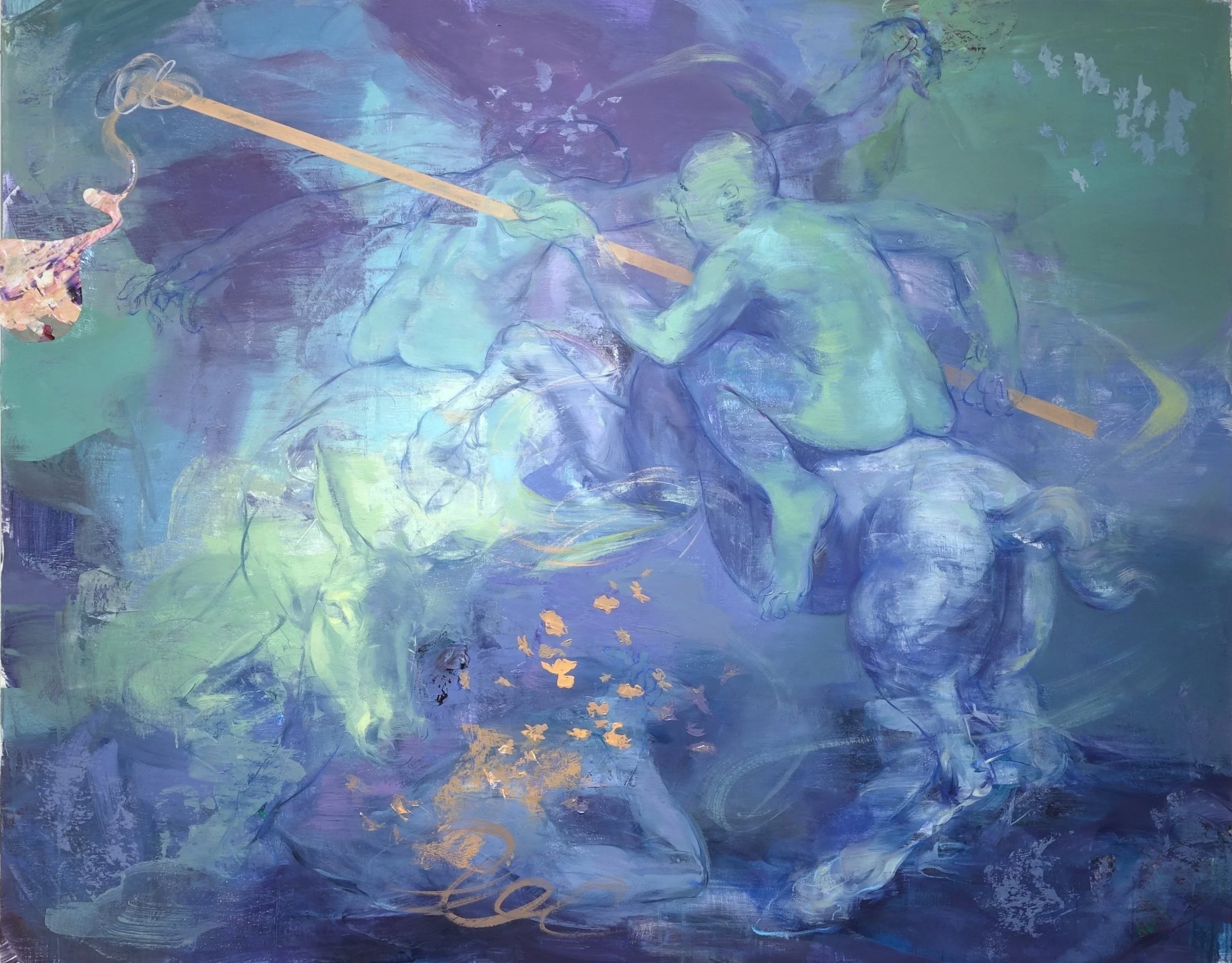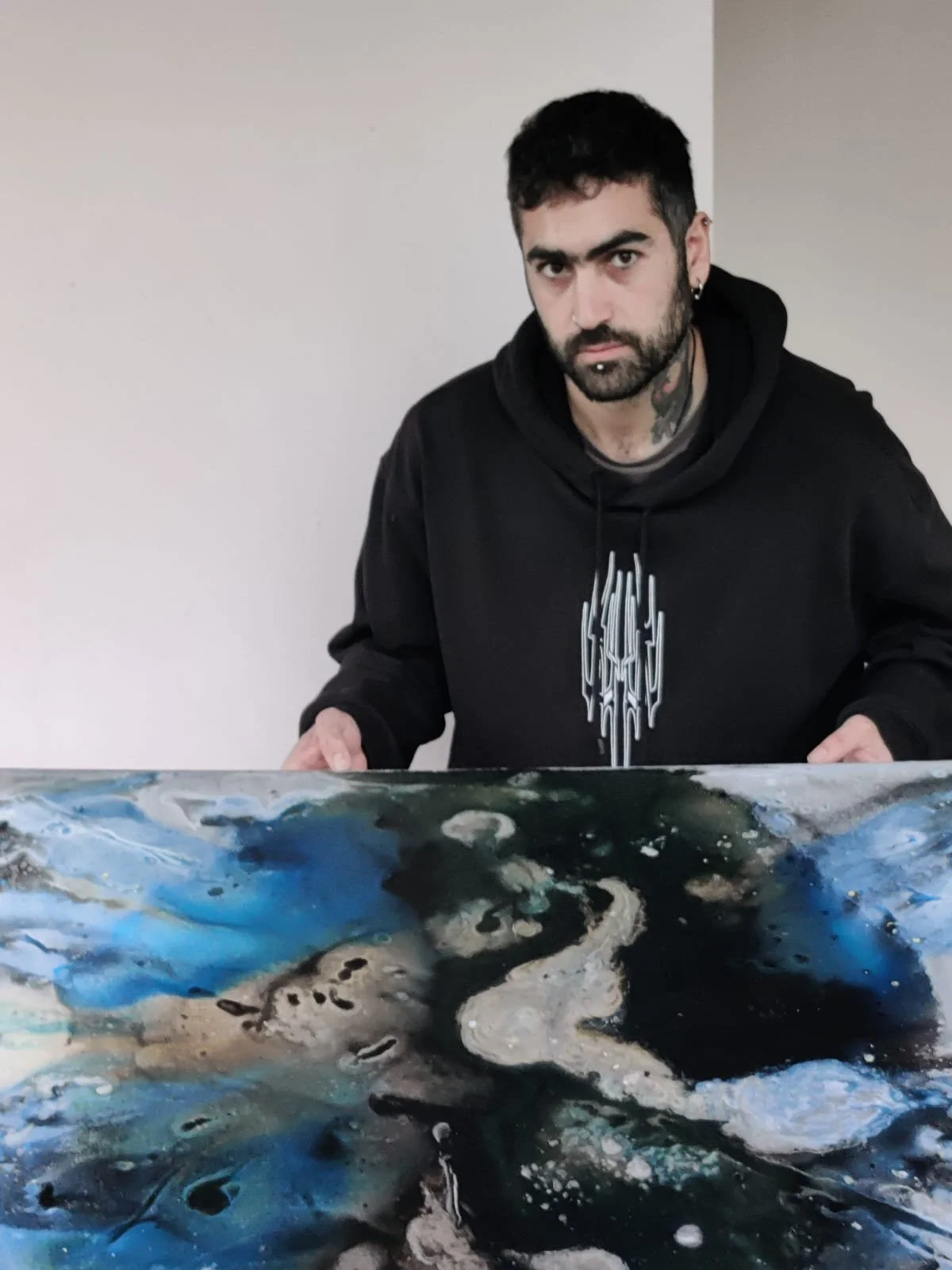10 Questions with Filip Moszant
Al-Tiba9 Art Magazine ISSUE18 | Featured Artist
Filip Moszant, born in 1987 in Avignon, France, lives in Warsaw, Poland. His work is an intuitive rebellion against imposed socialization. As a child, he instinctively transformed the rigid reality of the classroom into abstract compositions, drawn with markers, a subconscious defiance against conformity and a need for freedom. Over time, he developed a distinct visual language, much like the creators of Lascaux and Altamira, seeking direct, primal communication beyond artistic conventions.
His paintings, bold and unrestricted, reject the contemporary obsession with forced uniqueness, which paradoxically renders art cliché. Through spontaneous yet precise colour arrangements, he invites the viewer into a moment of “joyful disorientation”, where perception is freed from linear thinking.
Moszant does not dictate interpretation. In the spirit of Umberto Eco, he believes a creator “should not supply interpretations of his work; otherwise, he would not have created it.” His art remains open, an invitation to experience, rather than to explain.
Filip Moszant - Portrait
OddbbH, acrylic on canvas, 300x200 cm, 2019 © Filip Moszant
ARTIST STATEMENT
At the core of Moszant’s practice lies a deep engagement with form, texture, and movement. His paintings pulse with energy, shaped by unseen forces. Colours collide violently or dissolve into meditative softness, creating a balance between control and chaos. His acrylic markers and felt pens generate rhythmic gestures, while digital print techniques reinforce durability, preserving the raw intensity of his marks.
Though abstract, his work evokes landscapes, memories real or imagined, while vibrant colours suggest fleeting emotional states. Often working on a large scale, he immerses the viewer in a field of colour and motion, creating environments rather than mere images. Eroded layers and bold swaths of colour expand and release, revealing strata reminiscent of geological formations.
In a time dominated by digital imagery, Moszant reaffirms painting as a raw, tangible experience, an invitation to engage, explore, and ultimately, feel.
Ktk, print on carpet, 200x200 cm, 2024 © Filip Moszant
AL-TIBA9 ART MAGAZINE ISSUE18
INTERVIEW
Please tell us a little bit about your background and studies. What kind of education or training helped you develop your approach to art?
As a child, I noticed the moment I tried to deepen something I loved by bringing in a teacher or a course, it began to disgust or stress me. When I started drawing and painting around 12–14, I made a decision: no teachers. Despite my parents' advice, I chose to protect the joy and euphoria I felt when I created alone. That solitude became my education.
At 20, I entered formal art school and earned my bachelor's degree. I thought I'd never return to painting after that. But after three years of travel, I came back to Europe and applied for a master's degree at the Academy of Fine Arts in Poland. It was a good decision.
I met the only true teacher I've had inside a structured institution. He was more into the art of unlearning than into painting techniques instead of just going through the motions, as is often the case in art school. We peeled away layers from my mind I had unconsciously absorbed during my lifetime. That process brought me back to the gestures I made as a teenager and deepened them.
Since then, I've shown my work in group exhibitions across Poland and abroad, with recent features in publications like Altiba9, next month in ELLE Deco Poland and Contemporary Lynx and upcoming exhibitions planned for 2025.
As you mention in your statement, your paintings reject the contemporary obsession with forced uniqueness. How do you navigate the fine line between authenticity and artistic trends?
Good question... I don't know. This idea came from a friend who observed me. I have an intuitive/organic approach to life, and I do what feels good and makes me feel more alive. Sometimes, I feel very far from people, especially in the intellectual art world. But I still feel I belong. I wouldn't be here now if I was supposed to do something else. That sense of presence is enough.
K4, acrylic on canvas, 90x90 cm, 2020 © Filip Moszant
Zarathoustratarantules, acrylic on canvas, 100x100 cm, 2024 © Filip Moszant
You reference the creators of Lascaux and Altamira as inspirations. Do you see your work as a kind of primal or instinctive communication?
Yes, of course, I started painting to avoid talking. I noticed that I have feelings and dreams that seemed hard to explain to everyone, especially when I was a teenager. My paintings blur the line between the conscious and unconscious; no matter who is watching it, everybody can understand it on some level. You don't argue with it; you see it, you feel it, it takes root in the observer, and they bring their own story to it. It was for me, and it is still a way of communication, a weapon, and an act of survival.
The tension between control and chaos plays a key role in your work. How do you find balance when working with such dynamic forms and colours?
It's not something I search for; it arrives through the act. Chaos lives in my inner world: dreams, thoughts, emotional flashes. Control enters through my hands, through the tools, acrylic markers, and felt pens. They channel the energy but don't tame it. I begin with improvisation and instinct. Then I circle back: refine, subtract, re-enter. Some works demand speed, andothers ask for slowness. Balance isn't a goal; it's a moment that happens when I stop trying. Colour and form behave like living forces. I try not to cage them, only guide them. I want the viewer to feel that tension humming under the surface, like a wire drawn tight but not yet snapping.
Abstraction allows for a certain freedom of interpretation. Do you see your work as a dialogue with the viewer, or is it more of a personal act of expression?
It always starts as personal, a feeling I can't name, like trying to catch something before it falls. Each painting is a sentence half-written, left open so others can finish it with their own memories and questions. Abstraction gives space. It doesn't explain, it invites. Sometimes that space feels like a whisper, sometimes like a question, but always, like an invitation. That's why I connect with Jacques Rancière's idea of art as a redistribution of the sensible, where the viewer isn't passive but equally capable of constructing meaning. My work trusts that instinct, it doesn't guide, it allows.
Your use of acrylic markers, felt pens, and digital print techniques creates a unique materiality. How do these tools influence your creative process?
I work primarily with acrylic markers and felt pens on paper or canvas, translating these gestures into large-scale digital prints or installations. Markers are immediate. They don't allow hesitation. I make a mark; I commit to it. There's something urgent and pure in that. They let me move quickly, tracing an impulse before it vanishes. Then, I often photograph or scan those gestures and transform them into large-scale prints. It's a shift, from intimacy to architecture, from body to space. The contrast between those two scales allows me to build a rhythm that's both physical and atmospheric. You feel the hand and the memory it leaves behind.
Krj, acrylic on canvas, 55x55 cm, 2024 © Filip Moszant
Phosphene, acrylic on canvas, 91x95 cm, 2024 © Filip Moszant
Your paintings often evoke landscapes and memories, despite their abstract nature. Are they rooted in personal experience, or are they more universal?
I think it's both, but for sure, it's a personal experience. Sometimes, it's a memory; sometimes, it's a rhythm I don't recognize. I follow it like a scent through the woods. I never try to paint a place, but a sensation of one. A texture, a temperature, a sense of motion or stillness. The works often feel like maps, but not to places I've been more like maps of the inside. I think we all carry internal geographies. My paintings don't ask the viewer to understand mine. They invite them to remember their own terrain.
In an era dominated by digital imagery, what do you think is the role of painting as a physical, tangible medium?
People forget that digital art is math. No matter how abstract it looks, I'm in the presence of a calculation and coloured numbers. Not only digital imagery, but we live in a world conquered by mathematics since millenia. It's in time, currency, architecture, the design of cities, and the rhythm of our days. This quantification gave rise to civilization… but also slowly distanced us from intuition, mystery, fluidity, the invisible. I'm very intrigued by AI's dreamlike imagery and occasionally play with it, but to me, it feels like the cherry on top of the Sumerian civilization, a final flourish in a world long ruled by numbers. But painting, especially abstraction, is a way to break that Sumerian spell and return to something uncountable. It frees and clears our perception. Painting insists on presence. It slows you down and lets you connect to some layers that you're unaware of during daily tasks. You have to stand still in front of it and let your body respond. Unlike digital images, painting holds time, and layers of it. Each gesture is a residue of action, and each surface is a record of thought, mistake, and revision. In a world saturated by numbers dressed in colours, painting becomes a form of resistance, a quiet, tactile way of remembering what it means to feel with your eyes and to be a human.
F17, Acrylic on canvas, 110x100 cm, 2023 © Filip Moszant
What are you currently working on, and where do you see your practice evolving in the future?
Right now, I'm exploring how my visual language can move beyond the wall. Textiles, floor pieces, large-scale prints that surround the viewer. I want to create paintings you don't just look at; you move through them, get lost inside to refind yourself anew, a sort of labyrinth. I'm also drawn to architecture, not in a literal sense, but as a structure of feeling. I see my future work as more immersive, more environmental. Images that are not just seen, but lived inside.
Lastly, what are your goals for 2025? Are there any new exciting projects or exhibitions?
2025 feels like a time to go outside my comfort zone into the world and also the scale of my work, in its silence and resonance. I have a few group shows planned in Poland now, in April and May, centered around emotional abstraction. I'm applying for residencies abroad, and I'm curious to see how my work might shift in new contexts under different skies. I want to write more, to speak with images, but also reconnect to words. And I'd love to create a public installation, something site-specific and intimate, where the viewer becomes part of the piece just by being there. Mostly, I want to keep making space, for stillness, surprise and transformation.
























